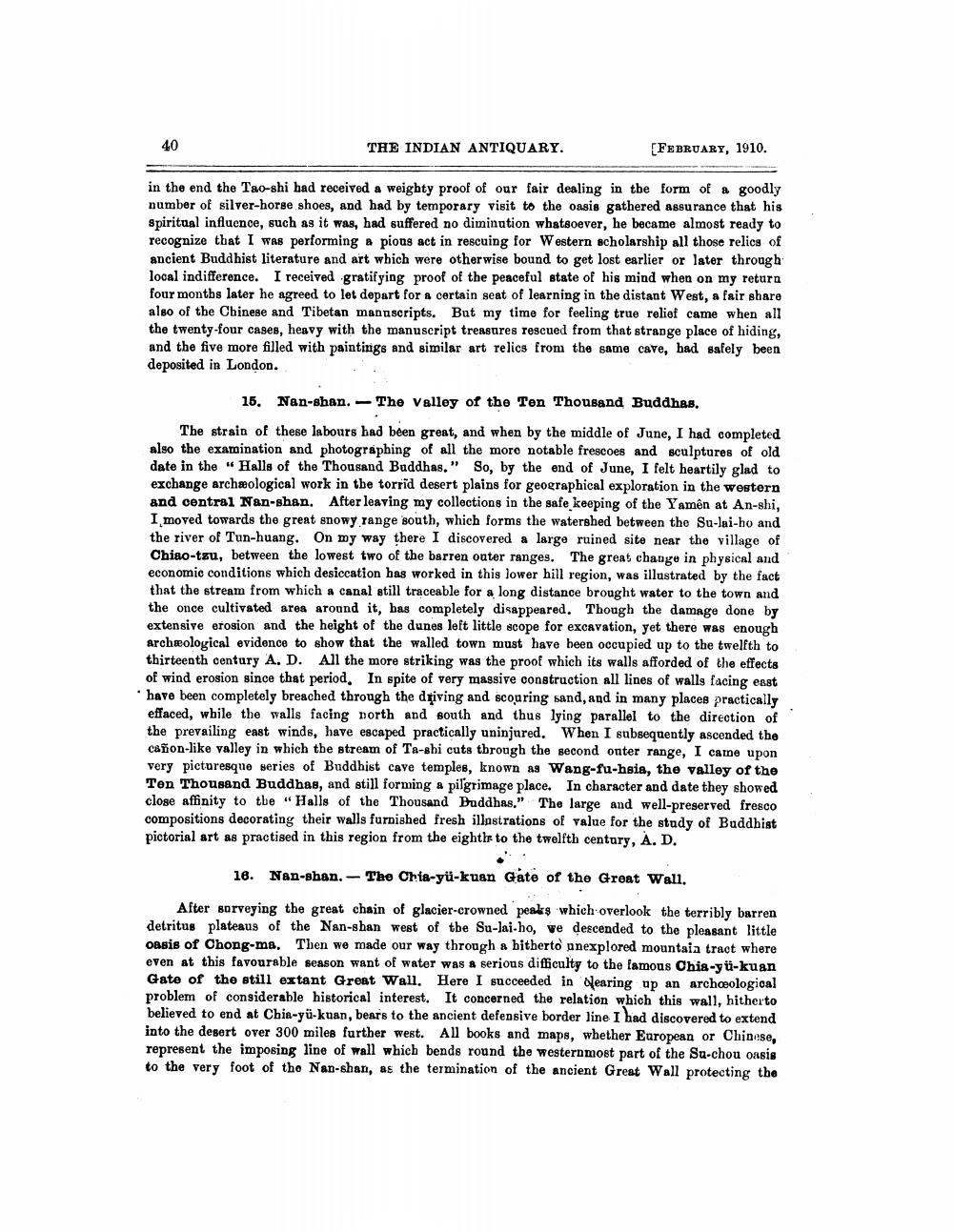________________
40
THE INDIAN ANTIQUARY.
[FEBRUARY, 1910.
in the end the Tao-shi had received a weighty proof of our fair dealing in the form of a goodly number of silver-horse shoes, and had by temporary visit to the oasis gathered assurance that his Spiritual influence, such as it was, had suffered no dimination whatsoever, he became almost ready to recognize that I was performing a pious act in rescuing for Western scholarship all those relics of ancient Buddhist literature and art which were otherwise bound to get lost earlier or later through local indifference. I received gratifying proof of the peaceful state of his mind when on my return four months later he agreed to let depart for a certain seat of learning in the distant West, a fair share also of the Chinese and Tibetan manuscripts. But my time for feeling true relief came when all the twenty-four cases, heavy with the manuscript treasures rescued from that strange place of hiding, and the five more filled with paintings and similar art relics from the same cave, bad safely been deposited in London.
15. Nan-shan - The Valley of the Ten Thousand Buddhas.
The strain of these labours had been great, and when by the middle of June, I had completed also the examination and photographing of all the more notable frescoes and sculptures of old date in the "Halls of the Thousand Buddhas." So, by the end of June, I felt heartily glad to exchange archæological work in the torrid desert plains for geographical exploration in the western and central Nan-shan. After leaving my collections in the safe keeping of the Yamên at An-shi, I moved towards the great snowy range south, which forms the watershed between the Su-lai-ho and the river of Tun-huang. On my way there I discovered a large ruined site near the village of Chiao-tzu, between the lowest two of the barren outer ranges. The great change in physical and economic conditions which desiccation has worked in this lower hill region, was illustrated by the fact that the stream from which a canal still traceable for a long distance brought water to the town and the once cultivated area around it, has completely disappeared. Though the damage done by extensive erosion and the height of the dunes left little scope for excavation, yet there was enough archæological evidence to show that the walled town must have been occupied up to the twelfth to thirteenth century A. D. All the more striking was the proof which its walls afforded of the effects of wind erosion since that period. In spite of very massive construction all lines of walls facing east have been completely breached through the diving and scouring band, and in many places practically effaced, while the walls facing north and south and thus lying parallel to the direction of the prevailing east winds, have escaped practically uninjured. When I subsequently ascended the cañon-like valley in which the stream of Ta-shi cuts through the second onter range, I came upon very picturesque series of Buddhist cave temples, known as Wang-fu-hsia, the valley of the Ten Thousand Buddhas, and still forming & pilgrimage place. In character and date they showed cloge affinity to the "Halls of the Thousand Buddhas." The large and well-preserved fresco compositions decorating their walls furnished fresh illustrations of value for the study of Buddhist pictorial art as practised in this region from the eighths to the twelfth century, A.D.
18. Nan-sban. - The Chia-yü-kuan Gate of the Great Wall.
After surveying the great chain of glacier-crowned peaks which overlook the terribly barren detritus plateaus of the Nan-shan west of the Su-lai-ho, ve descended to the pleasant little Oasis of Chong-ma. Then we made our way through a bitherto unexplored mountaia tract where even at this favourable season want of water was a serious difficulty to the famous Chia-yu-kuan Gate of the still extant Great Wall. Here I succeeded in Olearing up an archeological problem of considerable historical interest. It concerned the relation which this wall, hitherto believed to end at Chia-yü-kuan, bears to the ancient defensive border line I had discovered to extend into the desert over 300 miles further west. All books and maps, whether European or Chinese, represent the imposing line of wall which bends round the westernmost part of the Su-chou oasis to the very foot of the Nan-shan, as the termination of the ancient Great Wall protecting the




